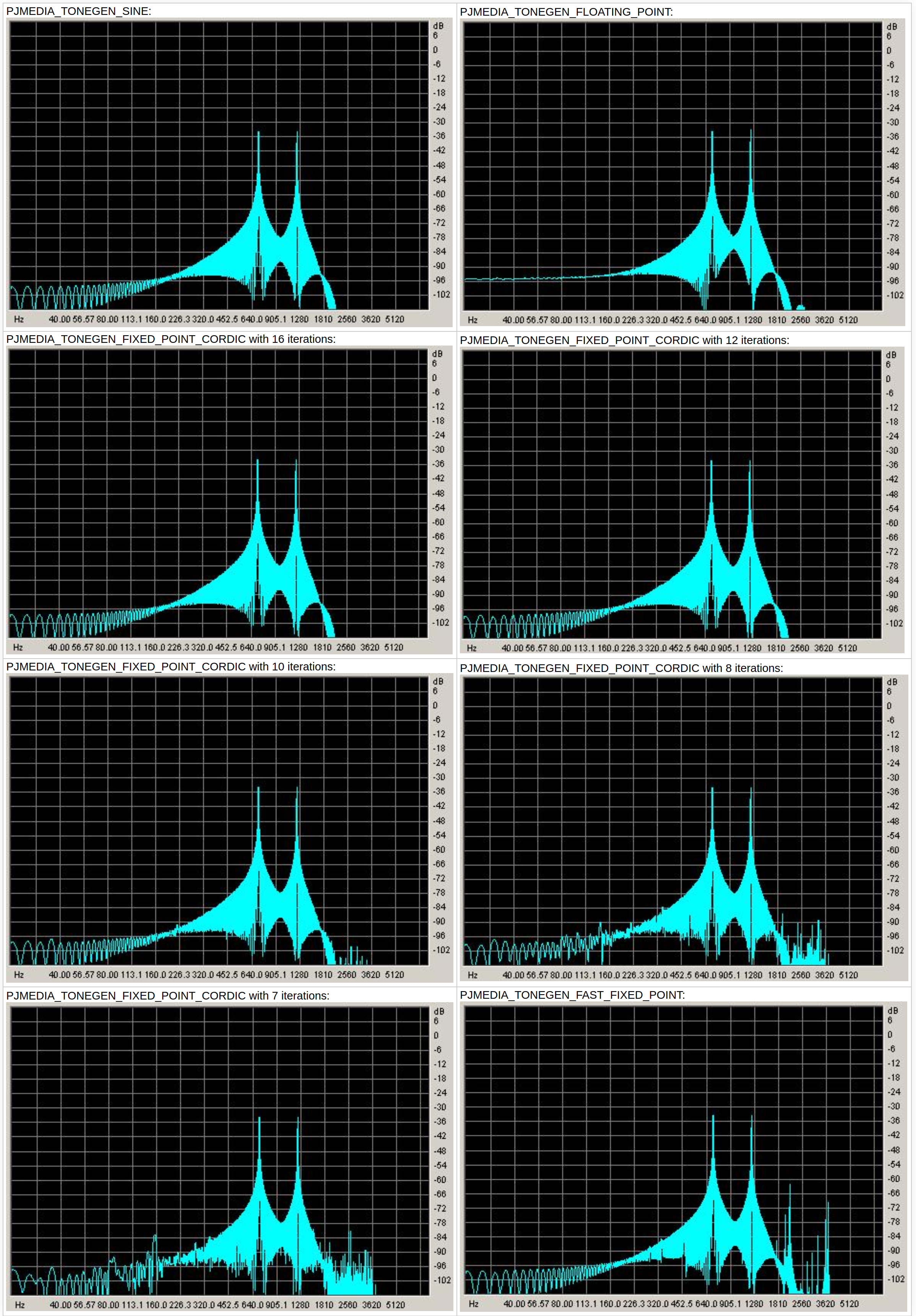Tone generator algorithms performance
This article presents the performance analysis of various back-end algorithms of the tone generator that are implemented in PJMEDIA. Both the performance in both speed and accuracy terms will be analyzed.
The Algorithms
The tone generator (tonegen.c) supports several algorithms, and since
version 1.0-rc3, the use of these algorithms can be controlled by
by using the PJMEDIA_TONEGEN_ALG macro setting:
PJMEDIA_TONEGEN_SINE: the good-old generation using math’s sine(), floating point. This has very good precision but it’s the slowest and requires floating point support and linking with the math library.PJMEDIA_TONEGEN_FLOATING_POINT: (default when floating point is enabled):: Floating point approximation of sine(). This has relatively good precision and much faster than plain (sine()*, but it requires floating-point support and linking with the math library.PJMEDIA_TONEGEN_FIXED_POINT_CORDIC: (new in 1.0-rc3, and the default when floating point is disabled):: Fixed point using sine signal generated by a 28-bit CORDIC algorithm. This algorithm can be tuned to provide balance between precision and performance by tuning thePJMEDIA_TONEGEN_FIXED_POINT_CORDIC_LOOPsetting, and it is suitable for platforms that lack floating-point support.PJMEDIA_TONEGEN_FAST_FIXED_POINT: Fast fixed point using some approximation to generate sine waves. The tone generated by this algorithm is not very precise, however the algorithm is very fast.
Accuracy
For the accuracy test, we setup the tone generator to generate digit A from DTMF, with frequencies of 697 and 1209. We then saved the tone to a WAV file and analyzed the frequency using CoolEdit (now becomes Adobe Audition).
This is simple to do with pjsua:
$ pjsua -play-tone 697,1209,200,2000 -rec-file tone.wav
then issue these commands:
cc 1 2
sleep 5000
cd 1 2
q
And here is the graphics from the frequency analysis.

Performance
Below is the time measurements of the algorithms. The test measures the generation of 1 second worth of dual-tone at 8KHz sampling rate. For single-tone, just divide the results by two, and for 16KHz dual-tone, just multiply the results by two.
The MIPS value uses the same convention as in Media Performance (MIPS test).
Linux, ARM9 (ARM926EJ-S), gcc
PJSIP was compiled with
-O3 -msoft-float -DNDEBUG -DPJ_HAS_FLOATING_POINT=0 flags.
time (usec) |
CPU (%) |
MIPS |
|
|---|---|---|---|
PJMEDIA_TONEGEN_SINE |
506,535 |
50.653 |
100.29 |
PJMEDIA_TONEGEN_FLOATING_POINT |
18,037 |
1.804 |
3.57 |
PJ MEDIA_TONEGEN_FIXED_POINT_CORDIC with 16 iterations |
17,694 |
1.769 |
3.50 |
PJ MEDIA_TONEGEN_FIXED_POINT_CORDIC with 12 iterations |
13,561 |
1.356 |
2.69 |
PJ MEDIA_TONEGEN_FIXED_POINT_CORDIC with 10 iterations |
11,662 |
1.166 |
2.31 |
PJ MEDIA_TONEGEN_FIXED_POINT_CORDIC with 8 iterations |
9,872 |
0.987 |
1.95 |
PJ MEDIA_TONEGEN_FIXED_POINT_CORDIC with 7 iterations |
8,943 |
0.894 |
1.77 |
PJMEDIA_TONEGEN_FAST_FIXED_POINT |
1,449 |
0.145 |
0.29 |
Windows, P4 2.66 GHz, Visual Studio 6
time (usec) |
CPU (%) |
MIPS |
|
|---|---|---|---|
PJMEDIA_TONEGEN_SINE |
1,348 |
0.135 |
10.92 |
PJMEDIA_TONEGEN_FLOATING_POINT |
605 |
0.060 |
4.90 |
P JMEDIA_TONEGEN_FIXED_POINT_CORDIC with 16 iterations |
1,372 |
0.137 |
11.12 |
P JMEDIA_TONEGEN_FIXED_POINT_CORDIC with 12 iterations |
1,140 |
0.114 |
9.24 |
P JMEDIA_TONEGEN_FIXED_POINT_CORDIC with 10 iterations |
998 |
0.100 |
8.09 |
P JMEDIA_TONEGEN_FIXED_POINT_CORDIC with 8 iterations |
826 |
0.083 |
6.69 |
P JMEDIA_TONEGEN_FIXED_POINT_CORDIC with 7 iterations |
743 |
0.074 |
6.02 |
PJMEDIA_TONEGEN_FAST_FIXED_POINT |
117 |
0.012 |
0.95 |
Conclusion
Based on the results above, and as of version 1.0-rc3, we set the tone generator settings in config_site.h as follows:
on PC and platforms where floating point is available:
#define PJMEDIA_TONEGEN_ALG PJMEDIA_TONEGEN_FLOATING_POINTon platforms where floating point is NOT available:
#define PJMEDIA_TONEGEN_ALG PJMEDIA_TONEGEN_FIXED_POINT_CORDIC #define PJMEDIA_TONEGEN_FIXED_POINT_CORDIC_LOOP 10
These settings of course can be overridden in your config_site.h as usual.